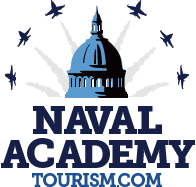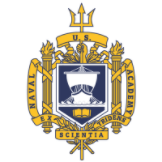In the 175+ year span of U.S. Naval Academy history, the USNA Planetarium is a relatively recent addition to the Yard. Tucked between Luce Hall and Macdonough Hall, known originally as Spitz Planetarium, it was installed in 1952. Since that time, this teaching space has provided invaluable opportunities for midshipmen and visitors to understand the positioning of the stars as we move through space. Over the years, the planetarium has received upgrades to keep the technology current. Come with us as we follow the trajectory of this out-of-this-world Maryland planetarium, a vital part of Annapolis history and the story of the Naval Academy.
In the Beginning: From Instruction at Sea to on Land—And Back Again
Before there was a planetarium, midshipmen learned about astronomy out at sea. However, with the incredible upheaval of World War II, it became exceedingly difficult (and truly impossible) to continue this type of training. To work around these challenges, the Naval Academy provided the Brigade with theoretical surface navigation courses so as commissioned officers, they could apply this knowledge to real-life situations. Unfortunately, this approach did not adequately prepare the midshipmen for their duties since they only had the opportunity to take and work out just a few of their own sights before becoming junior officers.
To remedy this shortfall, USNA acquired a Link Celestial Trainer, which they outfitted for surface navigation training and installed in a temporary building next to Luce Hall. The war ended shortly after, and with it the need for this trainer. Midshipmen were once again shipped out to sea to learn how to navigate by the stars during their practice cruises, and the trainer was soon forgotten.
A Real Planetarium: A Destination for Discovery
Fast forward to 1949, when it was proposed that the on-the-water instruction be complemented with the Link Trainer, which had been sitting idly in the unused space where it was first installed. As Lieutenant W. B. Hayler, U.S. Navy, describes in his article “The Naval Academy Gets a Planetarium,” in February 1952, “About two years ago the idea of supplementing the classroom navigation instruction of the second classmen reawakened interest in the unused Link building. The thought was that several lectures with the celestial sphere as a background would give the astronomy course a foundation not otherwise obtainable.”
The Department of Seamanship and Navigation began teaching a course for second-class midshipmen that covered navigation. The second-class midshipmen received training to help them grasp basic astronomy concepts including altitude, azimuth, right ascension, declination, siderial time and the celestial triangle. Additionally, they learned how to locate various constellations and recognize significant navigational stars. The planetarium was also used to instruct first-class midshipmen through a general information course designed for prospective Officers of the Deck (OOD).
USNA also used the planetarium to instruct other groups as well. In 1951, it ran demonstrations for the navigators competing in the Newport-Bermuda race so they could learn the stars and planets that would be visible along their intended route—and which would work best to use as intercepts for positioning.
The USNA Planetarium is its own otherworldly destination. It has hosted foreign naval attaches and members of both the American Astronomical Society (AAS) and the Institute of Navigation Institute (ION), as well as local scout groups, Annapolis field trips, families of faculty members, and other groups. Additionally, local Naval Reserve units and the Power Squadron have also used the planetarium to study the stars.
Infinity and Beyond: What You’ll Find Inside
The USNA Planetarium features a dome that’s 12.2 meters in diameter and space that can seat 115 people. Over the years, the planetarium’s capabilities have increased as the equipment has evolved from the 6.7m/45s/Spitz A1 in 1949, to a Spitz A3P in 1978 and a 12.2m/Starball Goto GX-12 in 1983. Used as a lecture hall as well, the planetarium offers core curriculum classes for Seamanship and Navigation, which are taught here and also supplemented with additional class time in the historic USNA Observatory.
Related: “A Star in Its Own Right: Exploring the Naval Academy Observatory.”
Currently, the USNA Astronomy Club also meets in the Luce Hall Planetarium and the USNA Observatory. This group brings together those interested “in the navigational stars of our past to infinity and beyond.”
Today, the planetarium continues to provide a vital role in furthering the astronomical education of the midshipmen, who will be helping to navigate their vessels by reading the stars. Even with today’s state-of-the-art technology and tools, the art of astronomy is always critical to the success of our U.S. Navy and Marine Corps. In times of war and strife, newer technology can fail—but the stars will always be there.
See the Stars
Come visit the planetarium and feel the stars' awesome power. When you visit the Yard, you’re supporting the midshipmen who support our country and protect its freedoms. All proceeds from USNA tours, dining experiences and shopping excursions (including Navyonline.com, the USNA Gift Shop at the USNA Visitor Center and the Midshipmen Store) go to the Brigade to help provide them with over 140 clubs, music, theater, cultural arts, club sports and much more. See the stars in this out-of-this-world planetarium. It’s an experience you’ll never forget.
-1.png)








